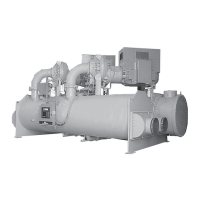JOHNSON CONTROLS
127
SECTION 2 – OPTIVIEW CONTROL CENTER
FORM 160.69-O1
ISSUE DATE: 9/30/2012
2
shutdown is performed. This check is only performed
under the following conditions:
• Chiller has been running for at least 10 minutes.
• Evaporator Refrigerant temperature (RT7) has
been enabled by a Service technician using in-
structions in YORK Service Manual 160.69.M1.
• Not in Brine cooling mode.
• Smart Freeze is enabled.
• Evaporator Temperature Sensor (RT7) or Evapo-
rator Saturation Temperature is indicating a tem-
perature of <32.0°F.
The chiller can be started after the temperatures are
within 3.0°F of one another and the COMPRESSOR
switch is placed in the Stop-reset (O) position.
“DISCHARGE #1 – HIGH PRESSURE CON-
TACTS OPEN”
The contacts of the electro-mechanical high pressure
switch (HP1, located in the discharge line of compres-
sor #1) have opened because it detected a pressure
>180.0 PSIG. The contacts will automatically close
when the discharge pressure decreases to < 120.0 PSIG
and
the COMPRESSOR Switch is placed in the Stop-reset
(O) position.
“DISCHARGE #2 – HIGH PRESSURE CON-
TACTS OPEN”
The contacts of the electro-mechanical high pressure
switch (HP2, located in the discharge line of compres-
sor #2) have opened because it detected a pressure
>180.0 PSIG. The contacts will automatically close
when the discharge pressure decreases to < 120.0 PSIG
and the
COMPRESSOR Switch is placed in the Stop-reset (O)
position.
“DISCHARGE #1 – HIGH TEMPERATURE”
The chiller (both compressors) has shutdown because
the discharge temperature of compressor #1, as sensed
by thermistor RT2, has increased to >220.0 ºF. The
chiller can be started after the temperature decreases to
<220.0 ºF and the COMPRESSOR switch is placed in
the Stop-reset (O) position.
With software version C.OPT.11.03.01.004 (or later),
if compressor #1 is locked-out using the Lockout key
on the Capacity Compressor Cycling Screen, this fault
does not cause compressor #2 to shutdown or prevent
it from starting. When this fault occurs on a locked-out
compressor, it is displayed as a warning. This allows
the user to know that a fault exists on the locked-out
compressor. The condition must be corrected prior to
the lockout being removed from the compressor. If it
is not, the warning condition will revert back to a shut-
down as soon as the lockout is removed and will cause
the chiller to trip.
“DISCHARGE #2 – HIGH TEMPERATURE”
The chiller (both compressors) has shutdown because
the discharge temperature of compressor #2, as sensed
by thermistor RT8, has increased to >220.0 ºF. The
chiller can be started after the temperature decreases to
<220.0 ºF and the COMPRESSOR switch is placed in
the Stop-reset (O) position.
With software version C.OPT.11.03.01.004 (or later),
if compressor #2 is locked-out using the Lockout key
on the Capacity Compressor Cycling Screen, this fault
does not cause compressor #1 to shutdown or prevent
it from starting. When this fault occurs on a locked-out
compressor, it is displayed as a warning. This allows
the user to know that a fault exists on the locked-out
compressor. The condition must be corrected prior to
the lockout being removed from the compressor. If it
is not, the warning condition will revert back to a shut-
down as soon as the lockout is removed and will cause
the chiller to trip.
“DISCHARGE #1 – LOW TEMPERATURE”
The chiller (both compressors) has shutdown because
the discharge temperature of compressor #1, as sensed
by thermistor RT2, has decreased to <30.0 ºF. The
chiller can be started after the temperature increases
to >30.0ºF and the COMPRESSOR switch is placed in
the Stop-reset (O) position.
With software version C.OPT.11.03.01.004 (or later),
if compressor #1 is locked-out using the Lockout key
on the Capacity Compressor Cycling Screen, this fault
does not cause compressor #2 to shutdown or prevent
it from starting. When this fault occurs on a locked-out
compressor, it is displayed as a warning. This allows
the user to know that a fault exists on the locked-out
compressor. The condition must be corrected prior to
the lockout being removed from the compressor. If it
is not, the warning condition will revert back to a shut-
down as soon as the lockout is removed and will cause
the chiller to trip.

